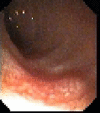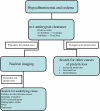Clinical practice. Protein-losing enteropathy in children
- PMID: 20571826
- PMCID: PMC2926439
- DOI: 10.1007/s00431-010-1235-2
Clinical practice. Protein-losing enteropathy in children
Abstract
Protein-losing enteropathy (PLE) is a rare complication of a variety of intestinal disorders characterized by an excessive loss of proteins into the gastrointestinal tract due to impaired integrity of the mucosa. The clinical presentation of patients with PLE is highly variable, depending upon the underlying cause, but mainly consists of edema due to hypoproteinemia. While considering PLE, other causes of hypoproteinemia such as malnutrition, impaired synthesis, or protein loss through other organs like the kidney, liver, or skin, have to be excluded. The disorders causing PLE can be divided into those due to protein loss from intestinal lymphatics, like primary intestinal lymphangiectasia or congenital heart disease and those with protein loss due to an inflamed or abnormal mucosal surface. The diagnosis is confirmed by increased fecal concentrations of alpha-1-antitrypsin. After PLE is diagnosed, the underlying cause should be identified by stool cultures, serologic evaluation, cardiac screening, or radiographic imaging. Treatment of PLE consists of nutrition state maintenance by using a high protein diet with supplement of fat-soluble vitamins. In patients with lymphangiectasia, a low fat with medium chain triglycerides (MCT) diet should be prescribed. Besides dietary adjustments, appropriate treatment for the underlying etiology is necessary and supportive care to avoid complications of edema. PLE is a rare complication of various diseases, mostly gastrointestinal or cardiac conditions that result into loss of proteins in the gastrointestinal tract. Prognosis depends upon the severity and treatment options of the underlying disease.
Figures
References
-
- Alpers DH, Stenson WF, Bier DM. Nutritional planning for patients with protein and calorie deficiency. In: Alpers DH, editor. Manual of nutritional therapeutics. 3. Boston: Brown; 1995. p. 265.
-
- Bach A, Babayan V. Medium-chain triglycerides: an update. Am J Clin Nutr. 1982;36:950–962. - PubMed
-
- Bennish ML, Salam MA, Wahed MA. Enteric protein loss during Shigellosis. Am J Gastroenterol. 1993;88(1):53–57. - PubMed
Publication types
MeSH terms
LinkOut - more resources
Full Text Sources
Other Literature Sources



